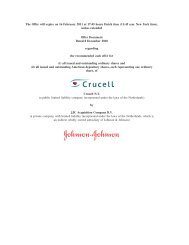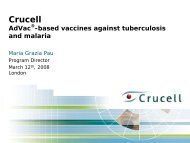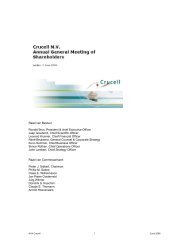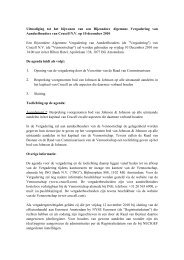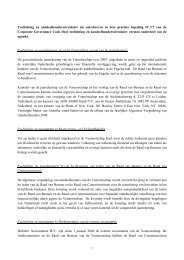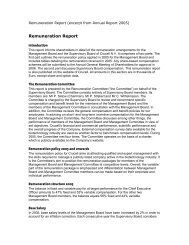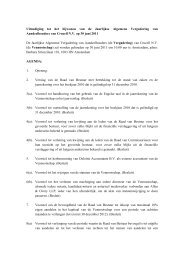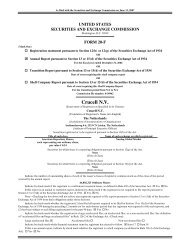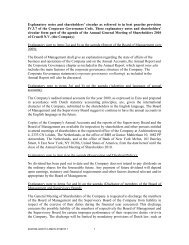Crucell corporate brochure (PDF)
Crucell corporate brochure (PDF)
Crucell corporate brochure (PDF)
Create successful ePaper yourself
Turn your PDF publications into a flip-book with our unique Google optimized e-Paper software.
Our business – Research and development<br />
In a pre-clinical study comparing CR6261 with the leading antiviral<br />
drug, oseltamivir, <strong>Crucell</strong>’s mAb strongly outperformed oseltamivir for<br />
influenza prevention and treatment. The study showed that CR6261<br />
provides immediate protection against influenza viruses, suggesting<br />
that it will be able to prevent disease spread and therefore ward off<br />
a threatening pandemic. In contrast, oseltamivir was less effective<br />
and in some cases, not effective at all.<br />
In September 2009, Johnson & Johnson, through its subsidiary<br />
Ortho-McNeil-Janssen Pharmaceuticals, Inc., entered into a strategic<br />
collaboration with <strong>Crucell</strong> for the development and commercialization<br />
of a universal mAb product (flu-mAb) for the treatment and prevention<br />
of influenza. An important recent step in the development of this<br />
flu-mAb has been the first production of this antibody product in a<br />
mobile and fully disposable FlexFactory®.<br />
Universal influenza vaccine (Discovery/Pre-clinical)<br />
The exciting flu-mAb research and development has laid the basis for<br />
the discovery and development of a vaccine that could protect against<br />
all subtypes of influenza virus.<br />
Hepatitis C antibody combination (Pre-clinical)<br />
Hepatitis C is a disease of the liver, caused by the hepatitis C virus (HCV).<br />
The virus can be transmitted by direct blood contact, for instance by<br />
sharing contaminated needles among drug users or by needle stick<br />
injuries in healthcare settings.<br />
Hepatitis C is a major global public health problem. A significant<br />
proportion of people (20–50%) develop progressive liver disease leading<br />
ultimately to liver cirrhosis, liver failure and hepatocellular carcinoma<br />
(HCC). 1 Most people who have been infected develop chronic disease.<br />
Symptomatic chronic HCV patients can be treated with antiviral agents<br />
(usually a combination of pegylated interferon and ribavirin), but with<br />
limited success. The only treatment option for end-stage liver disease<br />
is transplantation. HCV-induced cirrhosis is the leading cause for liver<br />
transplantation. It is estimated that up to 170 million people worldwide<br />
(3% of the world’s population) are infected with HCV. There is no<br />
available vaccine against HCV.<br />
In August 2009, <strong>Crucell</strong> obtained an exclusive license from Stanford<br />
University (Palo Alto, California) for the development of an antibody<br />
combination against HCV. A large panel of fully human mAbs against<br />
HCV is being evaluated by <strong>Crucell</strong> in a proof of concept phase. The mAbs<br />
have been found to neutralize the virus across all genotypes tested and<br />
each recognizes a different part of the HCV surface protein.<br />
19



